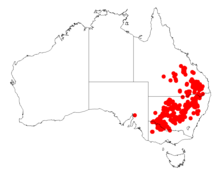| Yarran | |
|---|---|
| Scientific classification | |
| Kingdom: | Plantae |
| Clade: | Tracheophytes |
| Clade: | Angiosperms |
| Clade: | Eudicots |
| Clade: | Rosids |
| Order: | Fabales |
| Family: | Fabaceae |
| Subfamily: | Caesalpinioideae |
| Clade: | Mimosoid clade |
| Genus: | Acacia |
| Species: | A. melvillei |
| Binomial name | |
| Acacia melvillei Pedley | |

| |
| Occurrence data from AVH | |
Acacia melvillei, commonly known as yarran, is a shrub of the genus Acacia and the subgenus Plurinerves that is endemic to south eastern Australia.
Description
The tree can grow to a maximum height of around 15 m (49 ft) and has glabrous branchlets. Like most species of Acacia it has phyllodes rather than true leaves. The evergreen, leathery and ascending phyllodes have a narrowly elliptic or oblong-elliptic shape and are quite straight with a length of 5 to 10 cm (2.0 to 3.9 in) and a width of 5 to 25 mm (0.20 to 0.98 in) and have many closely parallel, obscure nerves where one to three are more prominent than the others. It blooms between August and November producing inflorescences that occur in groups of three to five found on an axillary axis with a length of 1 to 6 mm (0.039 to 0.236 in) and has spherical flower-heads with a diameter of 4 to 6 mm (0.16 to 0.24 in) containing 30 to 50 densely packed bright yellow flowers. The straight, flat and papery seed pods that form after flowering have more or less straight sides but are constricted between some seeds. The pods are up to 9 cm (3.5 in) in length and 7 to 10 mm (0.28 to 0.39 in) wide and sparsely haired.
Taxonomy
The species was first formally described by the botanist Leslie Pedley in 1978 as a part of the work A revision of Acacia Mill. in Queensland, Part 1 as published in the journal Austrobaileya. Pedley reclassified it as Racosperma melvillei in 1987 but it returned to the Acacia genus in 2001. The specific epithet honours Ronald Melville who was once a botanist at Kew Royal Botanic Gardens. The tree is similar in appearance to Acacia homalophylla and is thought to form hybrids with Acacia loderi.
Distribution
The range of the plant extends from around Clermont in south eastern Queensland in the north down to around Stanthorpe in the south east and throughout central New South Wales into the northern parts of Victoria as far south as Mildura and Kerang as a part of mixed open woodland communities growing in loam, clay and sandy soils. It dominates the endangered Acacia melvillei shrubland in the Riverina and Murray-Darling Depression bioregions in New South Wales where it occurs in pure stands or along with less abundant tall shrubs or trees including Acacia loderi, Alectryon oleifolius, Casuarina pauper and Myoporum platycarpum. The open canopy is followed by a scattered layer of mid-stratum shrubs then by a highly variable but sometimes sparse ground layer of grasses.
See also
References
- ^ "Acacia melvillei". World Wide Wattle. Western Australian Herbarium. Retrieved 12 December 2020.
- ^ "Acacia melvillei Pedley". PlantNet. Royal Botanic Garden, Sydney. Retrieved 12 December 2020.
- "Acacia melvillei Pedley". Atlas of Living Australia. Global Biodiversity Information Facility. Retrieved 12 December 2020.
- "Acacia melvillei Shrubland in the Riverina and Murray-Darling Depression bioregions - profile". New South Wales Government. Retrieved 13 December 2020.